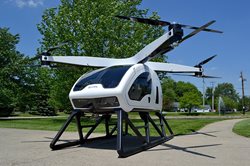When we think of grid simulators and their applications, we often imagine grid testing. It's true – grid simulators are frequently used as AC power supplies for turnkey test purposes and other battery management uses. However, they can be utilized in a number of interesting ways, many of which will directly contribute to technology of the future.
.jpg)
Electric vehicles (EV) have increasingly become the vehicle of choice for self-driving cars. If a car is completely autonomous, it would be counter intuitive to require an individual to pump gas for said car. And since it can't pump gas itself, the logical choice would be to design self-automated cars that are battery powered. One of the major concerns of today's EVs are limited range and the anxiety of running out of power mid-commute. Self-driving cars, by virtue of their technological infancy, are slow – we haven’t had enough years of research and testing to comfortably send them out with max speeds that rival a human-operated vehicle. They're also limited to a small range or travel. Today's iterations can only move about a very modest square-footage in order to ensure safety of the vehicle and passengers (taking it into densely populated, high-speed roads is imprudent at this time.) To handle frequent trips, it will recharge wirelessly with inductive pads (which are already happening today). None of this is accomplished without stringent testing of these cars and their battery efficacy – all of which is accomplished with grid simulators. Grid simulator equipment will test battery efficacy and life expectancy, giving automotive manufacturers a better look at how far, and for how long, an autonomous car can go. It’s a matter of upmost safety in a burgeoning, new market that is laying the groundwork for transportation of the future.
Another innovation in future technology requires the use of g

rid simulator testing. Flying air taxis, like EV, are built to be battery operated (and therefore, tested with a grid simulator). While range anxiety is worse in an air taxi than any other EV (the consequence of running out of power while mid-air is pretty grim), air taxis will, eventually, run solely on EV. Today’s successful versions operate on a system of both EV and traditional gasoline fueling. The small, two-passenger SureFly is powered by gasoline that can take you roughly 70 miles before refueling. It's complete with dual lithium battery packs for emergency landing power, in case the gasoline generator fails. Grid simulators are used to determine just how much air time that battery pack will give you – a key finding that is paramount to driver and passenger safety. As technology evolves and begins to rely more heavily on EV, grid simulators are increasingly being built to handle renewable energy testing, and can accurately test the power and efficiency of electric vehicle batteries.
Though we have to wait to see the full capacity of the electric-powered transportation engineers will design, we do know that it’ll be innovative and move the industry forward into the future. To learn more about the tools used to test green technology, visit our power supplies & loads page or contact us directly at (800)-404-2823.
Posted July 20, 2017